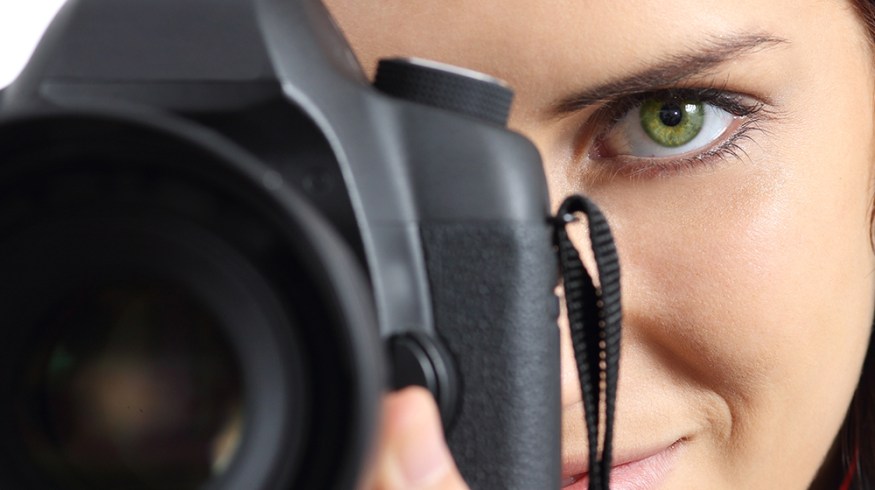
If the Human Eye Was a Camera, How Much Would It Cost?
The most impressive optical device at NAB is the one you already have.
Your eyes are much different than a camera on a lot of levels. For one, your eyes are rounded in the back and not flat like a camera sensor, although Sony would like to change that. Your eyes also add in information that is not always there. For example, the white or blue dress debate. Needless to say, a perfect comparison is not only impossible, it’s also unfair.
However, there are a few technical similarities in the way camera and eyeball optics work, and we thought it might be fun to put comparable eyeball specs side-by-side with modern day camera specs to see how much a theoretical camera would cost. To keep things simple, let’s look at each tech spec individually.
(Quick Note: I am not a doctor, just a man with Google.)
Focal Length

When we talk about focal length on a camera, we are literally talking about the distance from the optical center of the lens to the camera sensor. The same rule would apply in your eye. So, technically speaking, the average human eye would have a focal length of 17mm.
- Focal Length: 17mm
- Comparable Equipment: Olympus M.Zuiko 17mm f/2.8 Lens
- Price: $299
Angle of View

Whereas a 17mm lens on a full-frame camera would have a field-of-view of about 93 degrees, the average human eye has a field of view of about 180 degrees when facing forward. Using a simple angle of view calculator, the actual angle of view would equal that of a 1mm lens.
- Angle of View: 180 degrees
- Comparable Equipment: Nikkor 6mm Lens
- Price: $100,000
Crop Factor
With angle of view in mind, our 17mm eyeball has a focal equivalency of 1mm. So, theoretically, our eye has a negative crop factor of x.05 when compared to a full-frame camera. Needless to say, that technology does not exist in real life.
- Crop Factor: x.05
- Comparable Equipment: Metabones Speed Booster (x 14)
- Price: $7000
F-Stop
An F-stop is actually a very simple formula:

In an incredibly dark situation, an eye’s iris can expand to be about 8mm. So if we were to put that information into a formula with our focal length being the length of our eyes (about 17mm), we would get an actual f-stop of around f/2.1. That number is impressive, but certainly not earth-shattering.
- F-Stop: f/2.1 – f/8.3
- Comparable Equipment: Canon EF 35mm f/2 IS USM Lens
- Price: $549
Resolution

It’s estimated that the average human eye can read up to 576MP of information at any given time, giving a whole new meaning to the term retina display. Unfortunately, modern day DSLRs can’t quite take pictures at that high of a megapixel yet. However, in astronomy, there is a camera that comes close at 570MP.
- Resolution: 576MP
- Comparable Equipment: Dark Energy Camera
- Price: $35,000,000
ISO
ISO relates to the amount of power sent to the camera’s sensor at any given time. However, when you’re talking about your eyes, you don’t really have the ability to increase your sensitivity much beyond that of ISO 1,000 on a camera.
- ISO: 1 – 1000
- Comparable Equipment: Canon EOS DCS 3
- Price: $16,453 in 1995
Bit-Depth

It’s said that our eyes can perceive up to 10 million different colors. While that may seem like a lot, it is actually quite low in relation to what current cameras are capable of perceiving. Everyday, video cameras record color information at 8 bits-per-channel, but some cameras can record up to 14 bits per channel – that’s 4.4 trillion colors!
- Bit-Depth: 7.5 bits per channel
- Comparable Equipment: Everyday DSLR Video
- Price: $1,000
Dynamic Range

Dynamic range has to do with your camera’s ability to process both extremely bright and extremely dark details at the same time. Most professional grade cameras have a dynamic range of anywhere from 11-14 stops. The more stops your camera has, the greater its ability to record contrasting images. Surprisingly enough, when it comes to dynamic range, the human eye is on-par with modern technology.
- Dymaic Range: 10-14 Stops
- Comparable Equipment: Sony a7S
- Price: $2,498
Shutter Speed

Your eyes don’t have a mechanical or radial shutter, so they are more like an electronic shutter camera. However, if you want to compare the motion blur of your eye to a similar motion blur of a camera, simply wave your hand in from of your face at a constant rate. Do you see the motion blur?
If you were to adjust the shutter speed on a camera to match that of the motion blur found in your eye, you will arrive at a shutter speed of around 1/100-1/200. You probably don’t see very much motion blur in everyday life because your eyes are used to tracking moving objects incredibly fast. A technique very similar to this would be the way a car photographer tracks a moving car on a racetrack.
- Shutter Speed: 1/100 – 1/200
- Comparable Equipment: Everyday DSLR
- Price: $1,000
Frames-per-Second

Through research, scientists have been able to find out that humans can interpret information up to about 1,000fps. While you certainly can’t play this information back into your mind in slow motion (at least not yet), it does have bigger implications for the future of filmmaking and the number of FPS filmmakers should shoot in. This is why a 48fps movie like the Hobbit feels so much different than a 24fps movie.
- Frames-per-Second: 1,000fps
- Comparable Equipment: Phantom Flex 4K
- Price: $140,000
Grand Total: $35,268,799 + Tax
While it’s definitely impossible to say for sure what the actual cost of a human eye equivalent setup would be, if we were to add all of our prices together our theoretical camera would cost about as much as The Spongebob Movie: Sponge Out of Water made on opening weekend. (We live in dark times.)
Want to learn more about the comparison between the human eye and cameras? Check out a few of the following posts:
- The Photographic Eye – B&H
- Cameras v. The Human Eye – Cambridge in Color
- The Camera Versus the Human Eye – PetaPixel
Think this number should be higher or lower? Would you sell your eyeball for $35,000,000? Share you thoughts in the comments below.





